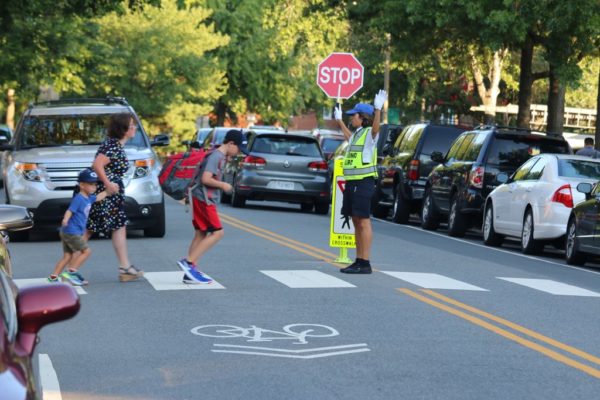
(Updated at 9:35 p.m.) Arlington County is looking to lower speed limits near schools as part of its ambitious Vision Zero initiative to eliminate serious traffic-related injuries and deaths by 2030.
This Saturday, the County Board is set to decide whether to authorize a public hearing next month to discuss and potentially approve creating “slow zones” on residential streets near 13 schools.
The proposed 58 zones, with a speed limit of 20 mph, will be near 11 Arlington public schools and well as Bishop O’Connell High School and St. Thomas More Cathedral School.
“Attempts to reduce or eliminate fatal and critical crashes can be achieved by regulating unsafe speeds on our streets with measures such as signage and pavement markings,” a county report said. “Lowering the speed limit can be a basic and powerful tool for reducing vehicle speeds.”
Traditionally, Arlington has installed flashing beacons to encourage drivers to adhere to reduced speed limits near schools. The report said these signs are inconsistently installed and are costly to maintain, while “static signage” and pavement markings, reminding drivers the speed limit is always 20 mph, are cheaper and easier to install.
The signage and markings will be tested out at these 13 sites before they’re installed across Arlington.
“Slower speeds around schools is a no-brainer, and are beneficial for everyone,” Vision Zero program manager Christine Sherman Baker told the Transportation Commission earlier this month. “We want to prioritize safety in school zones because children are still learning how to travel safely: how to cross the street, how to ride a bike. They’re some of our most vulnerable users.”
And they’re learning these skills in risky areas: according to the report, 10 or more speeding-related crashes annually happen within 600 feet of a school in Arlington.
Some schools were chosen because they’re new or have existing infrastructure in need of upgrades, she said. Hoffman-Boston Elementary, Drew Elementary and Gunston Middle schools were chosen because they’re near high-injury networks — and including them would help meet Vision Zero’s equity component.
This fall, Arlington County Police Department has been collecting speeding data that will be compared with new data collected next spring to see if these zones are effective, she said.
The community can provide feedback in March and April of next year, ahead of the county-wide roll out, she added.
The proposal was met with enthusiasm from Transportation Commission members and some members of the public.
“Bravo,” Transportation Commission Chair Chris Slatt said. “I think it’s fantastic.”
Representing local advocacy group Arlington Families for Safe Streets, Gillian Burgess voiced her support for the program during the meeting.
“Slower speeds around schools are not only great for the safety of vulnerable road users, but it also encourages activity, which addresses both child health and health equity,” she said. “It improves air quality and noise pollution around schools… and it promotes mental health and social inclusion.”
ACPD should also “commit publicly” to enforcing speeding near schools, preferably via speed cameras and not just for speeds 10 mph or more above the limit, while the county should consider closing streets in front of schools to cars, Burgess added.

